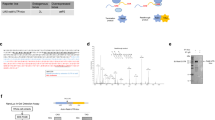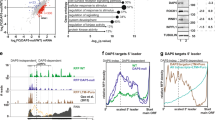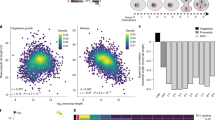Abstract
In eukaryotic cells, messenger RNAs harbouring premature termination codons (PTCs) are rapidly degraded by a conserved post-transcriptional mechanism referred to as nonsense-mediated mRNA decay (NMD)1,2, which prevents the synthesis of truncated proteins that could be deleterious for the cell1,2. Studies in yeast and mammals indicate that degradation by means of this pathway can occur from both the 5′ end of the message (involving decapping and 5′-to-3′ exonucleolytic digestion by XRN1) or the 3′ end (through accelerated deadenylation and exosome-mediated 3′-to-5′ decay)3,4,5,6,7,8,9. Here we show that, contrary to expectation, degradation of PTC-containing messages in Drosophila is initiated by endonucleolytic cleavage(s) in the vicinity of the nonsense codon. The resulting 5′ fragment is rapidly degraded by exonucleolytic digestion by the exosome, whereas the 3′ fragment is degraded by XRN1. This decay route is shown for several PTC-containing reporters, as well as an endogenous mRNA that is naturally regulated by NMD. We conclude that, despite conservation in the NMD machinery, PTC-containing transcripts are degraded in Drosophila by a mechanism that differs considerably from those described in yeast and mammals3,6,7.
This is a preview of subscription content, access via your institution
Access options
Subscribe to this journal
Receive 51 print issues and online access
$199.00 per year
only $3.90 per issue
Buy this article
- Purchase on Springer Link
- Instant access to full article PDF
Prices may be subject to local taxes which are calculated during checkout




Similar content being viewed by others
References
Wagner, E. & Lykke-Andersen, J. mRNA surveillance: the perfect persist. J. Cell Sci. 115, 3033–3038 (2002)
Wilusz, C. J., Wormington, M., Stuart, W. & Peltz, S. W. The cap-to-tail guide to mRNA turnover. Nature Rev. Mol. Cell Biol. 2, 237–246 (2001)
Cao, D. & Parker, R. Computational modeling and experimental analysis of nonsense-mediated decay in yeast. Cell 113, 533–545 (2003)
Chen, C. Y. & Shyu, A. B. Rapid deadenylation triggered by a nonsense codon precedes decay of the RNA body in a mammalian cytoplasmic nonsense-mediated decay pathway. Mol. Cell. Biol. 23, 4805–4813 (2003)
Hagan, K. W., Ruiz-Echevarria, M. J., Quan, Y. & Peltz, S. W. Characterization of cis-acting sequences and decay intermediates involved in nonsense-mediated mRNA turnover. Mol. Cell. Biol. 15, 809–823 (1995)
Lejeune, F., Li, X. & Maquat, L. E. Nonsense-mediated mRNA decay in mammalian cells involves decapping, deadenylating, and exonucleolytic activities. Mol. Cell 12, 675–687 (2003)
Mitchell, P. & Tollervey, D. An NMD pathway in yeast involving accelerated deadenylation and exosome-mediated 3′ → 5′ degradation. Mol. Cell 11, 1405–1413 (2003)
Muhlrad, D. & Parker, R. Premature translational termination triggers mRNA decapping. Nature 370, 578–581 (1994)
Muhlrad, D. & Parker, R. Aberrant mRNAs with extended 3′ UTRs are substrates for rapid degradation by mRNA surveillance. RNA 5, 1299–1307 (1999)
He, F. & Jacobson, A. Upf1p, Nmd2p, and Upf3p regulate the decapping and exonucleolytic degradation of both nonsense-containing mRNAs and wild-type mRNAs. Mol. Cell. Biol. 21, 1515–1530 (2001)
Ivanov, I. P., Simin, K., Letsou, A., Atkins, J. F. & Gesteland, R. F. The Drosophila gene for antizyme requires ribosomal frameshifting for expression and contains an intronic gene for snRNP Sm D3 on the opposite strand. Mol. Cell. Biol. 18, 1553–1561 (1998)
Persengiev, S. P., Zhu, X. & Green, M. R. Nonspecific, concentration-dependent stimulation and repression of mammalian gene expression by small interfering RNAs (siRNAs). RNA 10, 12–18 (2004)
Binder, R., Hwang, S. P., Ratnasabapathy, R. & Williams, D. L. Degradation of apolipoprotein II mRNA occurs via endonucleolytic cleavage at 5′-AAU-3′/5′-UAA-3′ elements in single-stranded loop domains of the 3′-noncoding region. J. Biol. Chem. 264, 16910–16918 (1989)
Binder, R. et al. Evidence that the pathway of transferrin receptor mRNA degradation involves an endonucleolytic cleavage within the 3′ UTR and does not involve poly(A) tail shortening. EMBO J. 13, 1969–1980 (1994)
Bremer, K. A., Stevens, A. & Schoenberg, D. R. An endonuclease activity similar to Xenopus PMR1 catalyzes the degradation of normal and nonsense-containing human beta-globin mRNA in erythroid cells. RNA 9, 1157–1167 (2003)
Brown, B. D. & Harland, R. M. Endonucleolytic cleavage of a maternal homeo box mRNA in Xenopus oocytes. Genes Dev. 4, 1925–1935 (1990)
Chernokalskaya, E. et al. A polysomal ribonuclease involved in the destabilization of albumin mRNA is a novel member of the peroxidase gene family. RNA 4, 1537–1548 (1998)
Cunningham, K. S., Dodson, R. E., Nagel, M. A., Shapiro, D. J. & Schoenberg, D. R. Vigilin binding selectively inhibits cleavage of the vitellogenin mRNA 3′-untranslated region by the mRNA endonuclease polysomal ribonuclease 1. Proc. Natl Acad. Sci. USA 97, 12498–12502 (2000)
Gallouzi, I. E. et al. A novel phosphorylation-dependent RNase activity of GAP-SH3 binding protein: a potential link between signal transduction and RNA stability. Mol. Cell. Biol. 18, 3956–3965 (1998)
Lee, C. H., Leeds, P. & Ross, J. Purification and characterization of a polysome-associated endoribonuclease that degrades c-myc mRNA in vitro. J. Biol. Chem. 273, 25261–25271 (1998)
Lim, S. K. & Maquat, L. E. Human beta-globin mRNAs that harbor a nonsense codon are degraded in murine erythroid tissues to intermediates lacking regions of exon I or exons I and II that have a cap-like structure at the 5′ termini. EMBO J. 11, 3271–3278 (1992)
Scheper, W., Meinsma, D., Holthuizen, P. E. & Sussenbach, J. S. Long-range RNA interaction of two sequence elements required for endonucleolytic cleavage of human insulin-like growth factor II mRNAs. Mol. Cell. Biol. 15, 235–245 (1995)
Stevens, A. et al. β-Globin mRNA decay in erythroid cells: UG site-preferred endonucleolytic cleavage that is augmented by a premature termination codon. Proc. Natl Acad. Sci. USA 99, 12741–12746 (2002)
van Dijk, E. L., Sussenbach, J. S. & Holthuizen, P. E. Identification of RNA sequences and structures involved in site-specific cleavage of IGF-II mRNAs. RNA 4, 1623–1635 (1998)
Wang, Z. & Kiledjian, M. Identification of an erythroid-enriched endoribonuclease activity involved in specific mRNA cleavage. EMBO J. 19, 295–305 (2000)
Dykxhoorn, D. M., Novina, C. D. & Sharp, P. A. Killing the messenger: short RNAs that silence gene expression. Nature Rev. Mol. Cell Biol. 4, 457–467 (2003)
Hayes, C. S. & Sauer, R. T. Cleavage of the A site mRNA codon during ribosome pausing provides a mechanism for translational quality control. Mol. Cell 12, 903–911 (2003)
Sunohara, T., Jojima, K., Yamamoto, Y., Inada, T. & Aiba, H. Nascent-peptide-mediated ribosome stalling at a stop codon induces mRNA cleavage resulting in nonstop mRNA that is recognized by tmRNA. RNA 10, 378–386 (2004)
Gatfield, D., Unterholzner, L., Ciccarelli, F. D., Bork, P. & Izaurralde, E. Nonsense-mediated mRNA decay in Drosophila: at the intersection of the yeast and mammalian pathways. EMBO J. 22, 3960–3970 (2003)
Bunch, T. A., Grinblat, Y. & Goldstein, L. S. Characterization and use of the Drosophila metallothionein promoter in cultured Drosophila melanogaster cells. Nucleic Acids Res. 16, 1043–1061 (1988)
Acknowledgements
We thank J. Rehwinkel for sharing information on the microarray analysis, K. Czaplinski for helpful discussions, and E. D. Andrulis, J. T. Lis, R. Lührmann and S. F. Newbury for antibodies. This study was supported by the European Molecular Biology Organisation (EMBO) and the Human Frontier Science Program Organization (HFSPO).
Author information
Authors and Affiliations
Corresponding author
Ethics declarations
Competing interests
The authors declare that they have no competing financial interests.
Supplementary information
Supplementary Figure 1
a, Efficiency of the XRN1 depletion. b, Comparison of decay rates of inducible CAT transcripts after inhibition of transcription by actinomycin D in untreated cells or cells depleted of XRN1 or UPF1.
Supplementary Figure 2
a, Depletion of individual components of the exosome or of SKI2 in cells expressing the CAT-PTC reporter leads to the accumulation of a 5' intermediate. b, Efficiency of the RRP4 depletion. c, The 3' degradation intermediate derived from the adh-64 reporter is polyadenylated.
Supplementary Figure 3
Mapping of the ends of the 5' and 3' intermediates for adh-64 and ODA mRNAs.
Rights and permissions
About this article
Cite this article
Gatfield, D., Izaurralde, E. Nonsense-mediated messenger RNA decay is initiated by endonucleolytic cleavage in Drosophila. Nature 429, 575–578 (2004). https://doi.org/10.1038/nature02559
Received:
Accepted:
Issue Date:
DOI: https://doi.org/10.1038/nature02559
This article is cited by
-
Novel insights into roles of N6-methyladenosine reader YTHDF2 in cancer progression
Journal of Cancer Research and Clinical Oncology (2022)
-
Nonsense-mediated RNA decay and its bipolar function in cancer
Molecular Cancer (2021)
-
SMG5-SMG7 authorize nonsense-mediated mRNA decay by enabling SMG6 endonucleolytic activity
Nature Communications (2021)
-
Molecular basis of transitivity in plant RNA silencing
Molecular Biology Reports (2019)
-
Upf proteins: highly conserved factors involved in nonsense mRNA mediated decay
Molecular Biology Reports (2018)
Comments
By submitting a comment you agree to abide by our Terms and Community Guidelines. If you find something abusive or that does not comply with our terms or guidelines please flag it as inappropriate.



